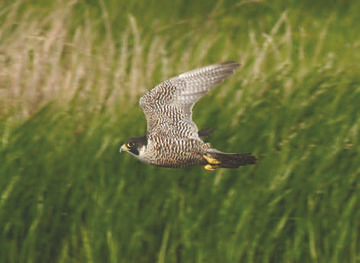
Peregrine © Steve Round
There are more Peregrines in the county now than have ever been recorded before, with birds found in winter in almost one quarter of tetrads. Coward (1910) wrote that one or two annually frequent the Dee estuary, often pursuing the wildfowl and pigeons crossing the water. They were also found in the southwest of the county, apparently feeding on Redwings. Most of the birds known to Coward were shot, and in the hill country ‘scarcely a winter passes without one or more being killed on the grouse moors’. Boyd (1951) knew it as an occasional winter visitor to mid-Cheshire.
Peregrines could now potentially be found almost anywhere in the county in winter. Large concentrations of waterfowl obviously attract them, with the Dee and Mersey estuaries and the Dee floods showing on the Atlas map with clusters of occupied tetrads, but they can find food anywhere. Winter Atlas surveyors reported them using a wide range of habitats. Farmland (47% of records) was most common, followed by semi-natural grassland and marsh, mostly saltmarsh, with 13% and human sites on 12%, mostly suburban. Water habitats comprised 9% freshwater and 10% marine, with even woodland and scrub recorded for 7% of tetrads. They take a wide range of prey, almost entirely birds and especially those species that flock, including Woodpigeons, gulls, ducks, waders, gamebirds and Fieldfares. Moorhens must be particularly unlucky as they often feature in lists of Peregrine diet although they do not seem to fit the normal profile of their prey. Urban Peregrines may well subsist almost entirely on feral pigeons and Starlings. Many birds are killed by the spectacular stoop, the Peregrine diving from on high and using its advantage of height and speed to knock its prey to the ground, but they also catch birds by flying after them almost in the manner of a Sparrowhawk, or flushing prey as a harrier does. Some birds are taken on the ground as well (Ratcliffe 1993). As with all falcons, the female is bigger than the male, half as heavy again, and she is more likely to take heavier prey. Peregrines occasionally dispossess another raptor of its prey, but Neil Friswell saw the tables turned at Tattenhall (SJ45Z) on 26 January 2005 when a male was chased off its kill by a Raven.
Breeding birds mostly stay in their territories, although a pair may temporarily split up and cover a larger area between them, but young birds disperse in the autumn and the winter birds in the county could have a range of origins. The median distance of movement is 45 km, but some ringed birds have been found more than 200 km from their natal site, although few Scandinavian Peregrines reach the west of Britain (Migration Atlas).
The winter population of the UK was estimated as 4,000 birds in the early 1980s (BTO Winter Atlas), since when the breeding population has doubled. In the three winters of this Atlas, fieldworkers recorded 95 birds in 74 tetrads in 2004/ 05, 85 birds in 66 tetrads in 2005/ 06, and 97 birds in 78 tetrads in 2006/ 07. Most individuals will range over several tetrads, and there will obviously be much double-counting, but fewer than half of the county’s tetrads were visited each winter, and there may well be between as many as 50 Peregrines in the county during winter.
Sponsored by Roy Bircumshaw

